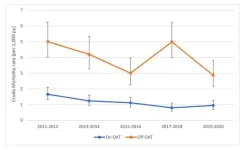(Press-News.org) Long term exposure to arsenic in water may increase cardiovascular disease and especially heart disease risk even at exposure levels below the federal regulatory limit (10µg/L) according to a new study at Columbia University Mailman School of Public Health. This is the first study to describe exposure-response relationships at concentrations below the current regulatory limit and substantiates that prolonged exposure to arsenic in water contributes to the development of ischemic heart disease.
The researchers compared various time windows of exposure, finding that the previous decade of water arsenic exposure up to the time of a cardiovascular disease event contributed the greatest risk. The findings are published in the journal Environmental Health Perspectives.
“Our findings shed light on critical time windows of arsenic exposure that contribute to heart disease and inform the ongoing arsenic risk assessment by the EPA. It further reinforces the importance of considering non-cancer outcomes, and specifically cardiovascular disease, which is the number one cause of death in the U.S. and globally,” said Danielle Medgyesi, a doctoral Fellow in the Department of Environmental Health Sciences at Columbia Mailman School. “This study offers resounding proof of the need for regulatory standards in protecting health and provides evidence in support of reducing the current limit to further eliminate significant risk.”
According to the American Heart Association and other leading health agencies, there is substantial evidence that arsenic exposure increases the risk of cardiovascular disease. This includes evidence of risk at high arsenic levels (>100µg/L) in drinking water. The U.S. Environmental Protection Agency reduced the maximum contaminant level (MCL) for arsenic in community water supplies (CWS) from 50µg/L to 10µg/L beginning in 2006. Even so, drinking water remains an important source of arsenic exposure among CWS users. The natural occurrence of arsenic in groundwater is commonly observed in regions of New England, the upper Midwest, and the West, including California.
To evaluate the relationship between long-term arsenic exposure from CWS and cardiovascular disease, the researchers used statewide healthcare administrative and mortality records collected for the California Teachers Study cohort from enrollment through follow-up (1995-2018), identifying fatal and nonfatal cases of ischemic heart disease and cardiovascular disease. Working closely with collaborators at the California Office of Environmental Health Hazard Assessment (OEHHA), the team gathered water arsenic data from CWS for three decades (1990-2020).
The analysis included 98,250 participants, 6,119 ischemic heart disease cases and 9,936 CVD cases. Excluded were those 85 years of age or older and those with a history of cardiovascular disease at enrollment. Similar to the proportion of California’s population that relies on CWS (over 90 percent), most participants resided in areas served by a CWS (92 percent). Leveraging the extensive years of arsenic data available, the team compared time windows of relatively short-term (3-years) to long-term (10-years to cumulative) average arsenic exposure. The study found decade-long arsenic exposure up to the time of a cardiovascular disease event was associated with the greatest risk, consistent with a study in Chile finding peak mortality of acute myocardial infarction around a decade after a period of very high arsenic exposure. This provides new insights into relevant exposure windows that are critical to the development of ischemic heart disease.
Nearly half (48 percent) of participants were exposed to an average arsenic concentration below California’s non-cancer public health goal <1 µg/L. In comparison to this low-exposure group, those exposed to 1 to <5 µg/L had modestly higher risk of ischemic heart disease, with increases of 5 to 6 percent. Risk jumped to 20 percent among those in the exposure ranges of 5 to <10 µg/L (or one-half to below the current regulatory limit), and more than doubled to 42 percent for those exposed to levels at and above the current EPA limit ≥10µg/L. The relationship was consistently stronger for ischemic heart disease compared to cardiovascular disease, and no evidence of risk for stroke was found, largely consistent with previous research and the conclusions of the current EPA risk assessment.
These results highlight the serious health consequences not only when community water systems do not meet the current EPA standard but also at levels below the current standard. The study found a substantial 20 percent risk at arsenic exposures ranging from 5 to <10 µg/L which affected about 3.2 percent of participants, suggesting that stronger regulations would provide significant benefits to the population. In line with prior research, the study also found higher arsenic concentrations, including concentrations above the current standard, disproportionally affect Hispanic and Latina populations and residents of lower socioeconomic status neighborhoods.
“Our results are novel and encourage a renewed discussion of current policy and regulatory standards,” said Columbia Mailman’s Tiffany Sanchez, senior author. “However, this also implies that much more research is needed to understand the risks associated with arsenic levels that CWS users currently experience. We believe that the data and methods developed in this study can be used to bolster and inform future studies and can be extended to evaluate other drinking water exposures and health outcomes.”
Co-authors are Komal Bangia, Office of Environmental Health Hazard Assessment, Oakland, California; James V. Lacey Jr and Emma S. Spielfogel, California Teacher Study, Beckman Research Institute, City of Hope, Duarte, California; and Jared A Fisher, Jessica M. Madrigal, Rena R. Jones, and Mary H. Ward, Division of Cancer Epidemiology and Genetics, National Cancer Institute.
The study was supported by the National Cancer Institute, grants U01-CA199277, P30-CA033572, P30-CA023100, UM1-CA164917, and R01-CA077398; and also funded by the Superfund Hazardous Substance Research and Training Program P42ES033719; NIH National Institute of Environmental Health Sciences P30 Center for Environmental Health and Justice P30ES9089, NIH Kirschstein National Research Service Award Institutional Research Training grant T32ES007322, NIH Predoctoral Individual Fellowship F31ES035306, and the Intramural Research Program of the NCI Z-CP010125-28.
Columbia University Mailman School of Public Health
Founded in 1922, the Columbia University Mailman School of Public Health pursues an agenda of research, education, and service to address the critical and complex public health issues affecting New Yorkers, the nation and the world. The Columbia Mailman School is the third largest recipient of NIH grants among schools of public health. Its nearly 300 multi-disciplinary faculty members work in more than 100 countries around the world, addressing such issues as preventing infectious and chronic diseases, environmental health, maternal and child health, health policy, climate change and health, and public health preparedness. It is a leader in public health education with more than 1,300 graduate students from 55 nations pursuing a variety of master’s and doctoral degree programs. The Columbia Mailman School is also home to numerous world-renowned research centers, including ICAP and the Center for Infection and Immunity. For more information, please visit www.mailman.columbia.edu.
END
Risk of cardiovascular disease linked to long-term exposure to arsenic in community water supplies
Understanding risk below the current US EPA regulatory standard
2024-10-23
ELSE PRESS RELEASES FROM THIS DATE:
Taking the “vibrational fingerprints” of molecules got 100 times faster
2024-10-23
Researchers Takuma Nakamura, Kazuki Hashimoto, and Takuro Ideguchi of the Institute for Photon Science and Technology at the University of Tokyo have increased by a 100-fold the measurement rate of Raman spectroscopy, a common technique for measuring the “vibrational fingerprint” of molecules in order to identify them. As the measurement rate has been a major limiting factor, this improvement contributes to advancements in many fields that rely on identifying molecules and cells, such as biomedical diagnostics and material analytics. The findings were published in the journal Ultrafast ...
Gardens prevent pollinators from starving when farmland nectar is scarce, new study finds
2024-10-23
Gardens offer a steady and reliable source of nectar all year round, helping to keep pollinators fed when farmland sources are limited, researchers have discovered.
This consistency means that even small patches of gardens in rural areas can sustain pollinators, particularly in early spring and late summer when nectar is scarce.
In the findings, published today in Proceedings of the Royal Society B, scientists at the University of Bristol discovered that gardens can provide between 50% and 95% of the total nectar during these critical ...
Addiction treatment decreases suicide risk among people with opioid dependence
2024-10-23
Treating opioid use disorder significantly lowers the very high rate (8 times the general population) of suicide among people with opioid dependence.
A Scottish study led by Glasgow Caledonian University of over 45,000 patients receiving methadone or buprenorphine for opioid use disorder reported this important result today in the scientific journal Addiction.
There were 575 suicides among the group of 46,453 people with opioid use disorder, accounting for 1.2% of the group. Although every member of the group received an OAT prescription at some point between 2011 and 2020, some ...
Abundant urban green space linked to lower rates of heat related illness and death
2024-10-22
Abundant green space in urban areas is linked to lower rates of heat related illness and death as well as better mental health and wellbeing, finds a systematic review of the available research, published in the open access journal BMJ Open.
Green space may help offset the adverse health effects of high temperatures, conclude the researchers.
In recognition of the detrimental heat related effects of increasing urbanisation and climate change, one of the UN Sustainable Development Goal targets stipulates the ...
Lifetime sudden cardiac death risk 4+ times higher for those with schizophrenia
2024-10-22
The lifetime risk of an unexpected and sudden death from a cardiovascular cause in the absence of pre-existing heart disease—known as sudden cardiac death—is more than 4 times higher for people with schizophrenia than it is for the general population, indicates Danish research published online in the journal Heart.
The risk is still around twice as high for those with other types of mental ill health, such as depression, whatever their age, indicate the findings, which suggest that an 18 year old can expect to live around 10 fewer years than someone of the same age without mental health issues.
The research to date indicates ...
Scurvy may be re-emerging amid cost of living crisis and rise of weight loss surgery
2024-10-22
The scourge of scurvy, which is caused by vitamin C deficiency, may be re-emerging amid the cost of living crisis and the rise in weight loss (bariatric) surgery, suggest doctors in the journal BMJ Case Reports after treating a middle-aged man with the condition.
Scurvy is eminently treatable, but because it’s a disease of the past, first associated with sailors during the Renaissance era, it may be mistaken for other conditions, especially inflamed blood vessels (vasculitis), potentially risking fatal bleeding if left untreated, highlight the authors.
Signs can appear as early as a month after a daily intake ...
Ethical framework aims to counter risks of geoengineering research
2024-10-22
WASHINGTON — As interest grows in geoengineering as a strategy for tackling global warming, the world’s largest association of Earth and space scientists today launched an ethical framework as a guide to responsible decision-making and inclusive dialogue.
The report, facilitated by the American Geophysical Union (AGU) and advised by a global panel of experts, says any research into large-scale interventions in Earth’s climate system must be grounded in sound ethical principles so society can make informed choices about whether to deploy them. It warns that the unintended consequences ...
New AI tool set to be a “game changer” in improving outcome predictions for kidney transplant patients
2024-10-22
A new advanced artificial intelligence (AI) tool, developed by renal doctors internationally, represents a significant step forward in predicting and potentially improving outcomes for UK kidney transplant patients.
For patients with late-stage renal failure, a kidney transplant can be life-changing, offering the promise of improved survival and a better quality of life compared to other treatment options. But in the UK alone, around 5,000 people are on the waiting list for a kidney transplant, ...
New VUMC hospital expansion to be named Jim Ayers Tower
2024-10-22
Vanderbilt University Medical Center will name the new expansion tower for Vanderbilt University Hospital the Jim Ayers Tower in recognition of Janet and Jim Ayers’ philanthropic legacy and abiding interest in improving the health care and quality of life for Tennesseans.
The naming of the 15-level, 470,000-square-foot tower, currently under construction between 21st Avenue South and Medical Center Drive on the Main Campus in Nashville, honors the couple’s steadfast community leadership and longtime connection to VUMC. The tower is scheduled to ...
New drug, WNTinib, delays tumor growth and improves survival in mouse models of children’s liver cancer
2024-10-22
Barcelona, Spain: A new drug called WNTinib can delay the growth of tumours and improve survival in hepatoblastoma, a type of liver cancer that occurs in young children. This effect was seen in cancer cells taken from patients and implanted into mice.
The researchers are now working on strategies to identify children who may benefit from the treatment, according to Ms Ugne Balaseviciute, a pre-doctoral researcher in the Translational Research in the Hepatic Oncology Group led by Professor Josep M, Llovet at Institut D'Investigacions Biomediques ...
LAST 30 PRESS RELEASES:
Quantum ‘alchemy’ made feasible with excitons
‘Revoice’ device gives stroke patients their voice back
USF-led study: AI helps reveal global surge in floating algae
New method predicts asthma attacks up to five years in advance
Researchers publish first ever structural engineering manual for bamboo
National poll: Less than half of parents say swearing is never OK for kids
Decades of suffering: Long-term mental health outcomes of Kurdish chemical gas attacks
Interactional dynamics of self-assessment and advice in peer reflection on microteaching
When aging affects the young: Revealing the weight of caregiving on teenagers
Can Canada’s health systems handle increased demand during FIFA World Cup?
Autistic and non-autistic faces may “speak a different language” when expressing emotion
No clear evidence that cannabis-based medicines relieve chronic nerve pain
Pioneering second-order nonlinear vibrational nanoscopy for interfacial molecular systems beyond the diffraction limit
Bottleneck in hydrogen distribution jeopardises billions in clean energy
Lung cancer death rates among women in Europe are finally levelling off
Scientists trace microplastics in fertilizer from fields to the beach
The Lancet Obstetrics, Gynecology, & Women’s Health: Taking paracetamol during pregnancy does not increase risk of autism, ADHD or intellectual disabilities, confirms new gold-standard evidence review
Taking paracetamol during pregnancy does not increase risk of autism, ADHD or intellectual disabilities
Harm reduction vending machines in New York State expand access to overdose treatment and drug test strips, UB studies confirm
University of Phoenix releases white paper on Credit for Prior Learning as a catalyst for internal mobility and retention
Canada losing track of salmon health as climate and industrial threats mount
Molecular sieve-confined Pt-FeOx catalysts achieve highly efficient reversible hydrogen cycle of methylcyclohexane-toluene
Investment in farm productivity tools key to reducing greenhouse gas
New review highlights electrochemical pathways to recover uranium from wastewater and seawater
Hidden pollutants in shale gas development raise environmental concerns, new review finds
Discarded cigarette butts transformed into high performance energy storage materials
Researchers highlight role of alternative RNA splicing in schizophrenia
NTU Singapore scientists find new way to disarm antibiotic-resistant bacteria and restore healing in chronic wounds
Research suggests nationwide racial bias in media reporting on gun violence
Revealing the cell’s nanocourier at work
[Press-News.org] Risk of cardiovascular disease linked to long-term exposure to arsenic in community water suppliesUnderstanding risk below the current US EPA regulatory standard




